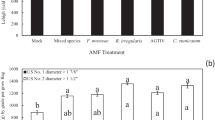Abstract
Tubers of 11 potato clones were compared for susceptibility to blackspot and soft rot, redox potential, ascorbic acid, dry matter, and potassium content. Evaluations were made before and after 6 mo storage at 3.9C. Clonal behavior was generally consistent over 2 yr. Significant differences occurred among clones for each factor except redox potential.
Blackspot and soft rot were positively correlated in 5 of 8 comparisons. Neither blackspot nor soft rot was correlated with ascorbic acid or redox potential. Blackspot was positively correlated with dry matter in the fall but not after storage and was negatively correlated with potassium. Soft rot evaluated in air or air plus 8% CO2 was positively correlated with dry matter in only 2 of 8 comparisons. Soft rot susceptibility did not increase with storage when inoculated discs were incubated in air but did increase when the discs were incubated in air plus 8% CO2.
Ascorbic acid was negatively correlated with redox potential only before storage and decreased to varying degrees in all clones during storage.
Resumen
Tubérculos de 11 clones fueron comparados en susceptibilidad a mancha negra y pudrición blanda, potencial redox, ácido ascórbico, materia seca y contenido de potasio. Las evaluaciones fueron hechas antes y después de 6 meses de almacenamiento a 3.9°C. El compartamiento clonal fue generalmente consistente a lo largo de 2 años. Ocurrieron diferencias significativas entre los clones para cada factor, excepto potencial redox.
La incidencia de mancha negra y pudrición blanda fue correlacionada directamente en 5 de 8 comparaciones. Ni mancha negra ni pudrición blanda mostraron correlación con ácido ascórbico o potencial redox. La presencia de mancha negra estuvo correlacionada positivamente al contenido de materia seca en el otoño, pero no después del almacenamiento y estuvo negativamente correlacionada con el contenido de potasio. La pudrición blanda, evaluada en aire, o aire más 8% CO2, estuvo correlacionada positivamente con materia seca en sólo 2 de 8 comparaciones. La susceptibilidad a pudrición blanda no aumento con el almacenamiento cuando los discos inoculados fueron incubados en aire, pero si aumentó cuando los discos fueron incubados en aire más 8% CO2.
El ácido ascórbico estuvo correlacionada negativamente con el potencial redox sólo antes del almacenamiento y decredió en grado diferente en los distintos clones durante el almacenamiento.
Similar content being viewed by others
Literature Cited
Altman, F.P. 1969 B. The use of eight different tetrazolium salts for a quantitative study of pentose-shunt dehydrogenation. Histochemie 19:363–374.
Clark, D. 1973. The accumulation of scopolin in potato tissue in response to infection. Physiol Plant Pathol 3:347–358.
Dwelle, R.B., G.B. Stallknecht, R.E. McDole and J.J. Pavek. 1977. Effect of soil potash treatment and storage temperature on blackspot bruise development in tubers of fourSolarium tuberosum cultivars. Am Potato J 54:137–146.
Farkas, G.L., Z. Kiraly and F. Solymozy. 1960. Role of oxidative metabolism in the localization of plant viruses. Virology 12:408–421.
Hughes, J.C. 1974. Factors influencing quality of ware potatoes. 2. Environmental factors. Potato Res 17:512–547.
Johnson, G. and L.A. Schaal. 1957. Accumulation of phenolic substances and ascorbic acid in potato tuber tissue upon injury and their possible role in disease resistance. Am Potato J 34:200–209.
Killick, R.J. and A.W. Macarthur. 1980. The relationship between bruising and specific gravity in some potato varieties. Potato Res 23:457–461.
Lovrekovich, L., H. Lovrekovich and M.A. Stahmann. 1967. Inhibition of phenol oxidation by Erwinia carotovora in potato tuber tissue and its significance in disease resistance. Phytopathology 57:737–742.
Mulder, E.G. 1949. Mineral nutrition in relation to the biochemistry and physiology of potatoes. I. Effect of nitrogen, phosphate, potassium, magnesium and copper nutrition on the tyrosine content and tyrosinase activity with particular reference to blackening of tubers. Plant and Soil 2:59–121.
Szent-Gyorgi, A. and K. Vietorisz. 1931. An early study on the possible role of phenol oxidizing enzymes in the disease resistance of the potato plant. Biochem Z 233:236–239.
Vertregt, N. 1968. Relation between blackspot and composition of the potato tuber. Eur Potato J 11:34–44.
Author information
Authors and Affiliations
Additional information
Contribution from Colorado State University Agricultural Experiment Station, Fort Collins, Colorado 80523. Scientific Paper No. 2939.
Rights and permissions
About this article
Cite this article
Workman, M., Holm, D.G. Potato clone variation in blackspot and soft rot susceptibility, redox potential, ascorbic acid, dry matter and potassium. American Potato Journal 61, 723–733 (1984). https://doi.org/10.1007/BF02888975
Accepted:
Issue Date:
DOI: https://doi.org/10.1007/BF02888975




